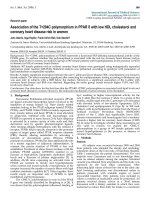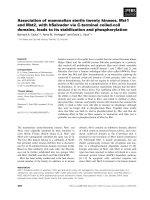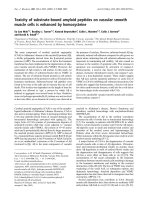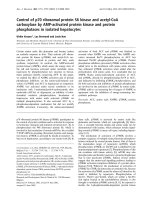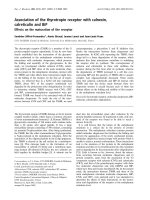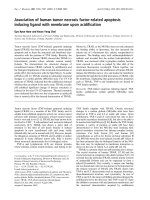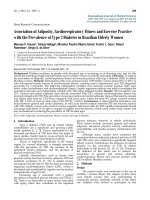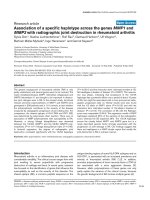Báo cáo y học: "Association of various reproductive rights, domestic violence and marital rape with depression among Pakistani women" docx
Bạn đang xem bản rút gọn của tài liệu. Xem và tải ngay bản đầy đủ của tài liệu tại đây (291.57 KB, 13 trang )
BioMed Central
Page 1 of 13
(page number not for citation purposes)
BMC Psychiatry
Open Access
Research article
Association of various reproductive rights, domestic violence and
marital rape with depression among Pakistani women
Faridah A Ali*
1,2
, Syed M Israr
†1,3
, BadarSAli
†2
and Naveed Z Janjua
†1,4
Address:
1
Department of Community Health Sciences, Aga Khan University, Karachi, Pakistan,
2
Department of Family Medicine, Aga Khan
University, Karachi, Pakistan,
3
TACMIL Health Project, Islamabad, Pakistan and
4
British Columbia Centre for Disease Control, Vancouver, Canada
Email: Faridah A Ali* - ; Syed M Israr - ; Badar S Ali - ;
Naveed Z Janjua -
* Corresponding author †Equal contributors
Abstract
Background: Depression among women is common in developing countries. Gender inequality
can contribute to women's risk for depression. Lack of reproductive and sexual rights is an
important marker of gender inequality and women do not have the freedom to express their
reproductive and sexual needs in many parts of the world. Therefore we designed this study to
determine the association of depression with lack of various reproductive rights and domestic
violence among married women in Karachi, Pakistan.
Methods: A case-control study with 152 cases and 152 controls, which included women 15-48
years, recruited from two teaching hospitals from 1
st
June 2007 through 31
st
August 2007. The SRQ
was administered to all subjects. A cut off score of 8 was used to confirm cases of depression
diagnosed by physicians, and to exclude cases of depression from the controls. Self-administered
questionnaire was used to assess the risk factors.
Results: 61% of the cases and 43% of the controls were ever abused by spouse and the frequency
of marital rape was 33% in cases and 13% in controls. After adjusting for the effects of other
variables in the model, less than 18 years of age at marriage (OR 2.00; 95% CI = 1.07, 3.7), decision
for marriage by parents (OR 3.51; 95% CI = 1.67, 7.37), abuse by in laws (OR 4.91; 95% CI = 2.66,
9.06), ≤ 3 hours per day spent with husband (OR 2.33; 95% CI = 1.34, 4.08), frequency of
intercourse ≤ 2 times per week (OR 1.85; 95% CI = 1.06, 3.22) and marital rape (OR 3.03; 95% CI
= 1.50, 6.11) were associated with depression among women.
Conclusion: In our study depression in married women was associated with younger age at
marriage, lack of autonomy in marriage decisions, marital rape and domestic abuse by in-laws.
Efforts should be directed towards creating awareness about the reproductive and sexual rights of
women in Pakistan. Physicians should be trained to screen and identify women who may be at risk
for psychological distress as a result of denial of reproductive rights so that they can support
positive mental health outcomes through individual, family or marital counseling.
Published: 1 December 2009
BMC Psychiatry 2009, 9:77 doi:10.1186/1471-244X-9-77
Received: 6 May 2009
Accepted: 1 December 2009
This article is available from: />© 2009 Ali et al; licensee BioMed Central Ltd.
This is an Open Access article distributed under the terms of the Creative Commons Attribution License ( />),
which permits unrestricted use, distribution, and reproduction in any medium, provided the original work is properly cited.
BMC Psychiatry 2009, 9:77 />Page 2 of 13
(page number not for citation purposes)
Background
Reproductive rights rest on "the right of all couples and
individuals to decide freely and responsibly the number,
spacing and timing of their children, to have the informa-
tion and means to do so, and the right to attain the high-
est standard of sexual and reproductive health; including
the right to make decisions concerning sex and reproduc-
tion free of discrimination, coercion and violence". Gen-
der discrimination is an important factor which deprives
women of their reproductive rights [1].
Sexual rights are an important part of reproductive rights
which include "The right to sexual freedom, autonomy,
integrity, and safety of the sexual body. It also includes the
right to sexual privacy, equity, sexual pleasure, emotional
sexual expression, the right to sexually associate freely,
right to make free and responsible reproductive choices,
the right to sexual information, education and the right to
sexual health care"[2].
In Pakistan, women are under-privileged in meeting their
sexual needs and in freedom of choice of their partners,
which has implications for women's reproductive behav-
ior and human rights. This gender inequality decreases
women's ability to have a healthy sex life, and increases
their risk of violence and mental disorders [3-5].
Studies have found a correlation of depression with cer-
tain reproductive rights, such as younger age at marriage
and marital rape [6-8]. Marital rape is any unwanted inter-
course or penetration (vaginal, anal, or oral) obtained by
force, threat of force, or when the wife is unable to consent
[9]. Commonly it is perceived that women are raped by
men other than their partners but data have revealed that,
over 75% of the women who have been physically or sex-
ually abused, report abuse by their partner. About 10-20%
of the women surveyed in 5 out of 10 countries believed
that a woman does not have a right to refuse sex to her
husband under any circumstances [10]. It is now a crime
in most parts of the Western world [9] but the Pakistani
law still fails to recognize marital rape as a crime [11].
Although the association of depression with autonomy to
decide about contraception has not been studied in the
past, it is known that the stress of an unintended preg-
nancy or unsafe abortion might be expected to increase
the risk of onset or recurrence of serious mental ill-health
[12].
Domestic violence is also a risk factor for depression
among women [7,13,14]. A study in Pakistan reported
that 34% of women are physically abused, and of these
72% had anxiety/depression [15]. In another study in
Pakistan, 95% men reported perpetrating verbal abuse
during their marital life, which implies that verbal abuse
by male partners is viewed as a norm [16]. Women also
view a certain amount of physical abuse, as justified under
certain conditions. For instance, 80% of women surveyed
in rural Egypt said that beatings were common and often
justified, particularly if the woman refused to have sex
with her husband [17]. In a World Health Organization
(WHO) report, studies conducted in 10 countries revealed
that women who had ever experienced physical or sexual
partner violence, or both, reported significantly higher
levels of emotional distress and were more likely to have
thought of suicide or to have attempted suicide, than were
women who had never experienced partner violence [10].
Studies from Pakistan indicate that depression is common
in women and reported various social and sociodemo-
graphic risk factors associated with depression in women
[13,14,18-23]. However, the relationship between repro-
ductive rights of women and depression has never been
assessed. Exploring women's reproductive rights and their
association with depression is more important in Paki-
stani context because of the specific culture, where women
do not have control over their own reproduction [12] and
disclosure of their sexual needs is difficult, and often stig-
matized.
Reproductive rights is not only absence of reproductive ill-
ness but the right to life and health, rights to bodily integ-
rity and security, the right to the benefits of scientific
progress (e.g. control of reproduction), the right to sexual
education, the right to equality in marriage and divorce
and the right to non-discrimination [12]. Therefore this
study aimed to determine the association of depression in
married women in Pakistan with lack of various reproduc-
tive rights and other markers of gender inequality, like
domestic violence.
Methods
Study design and study participants
A case control study was conducted at psychiatry and fam-
ily medicine clinics of Aga Khan University Hospital
(AKUH) and psychiatry clinics at Liaquat National Hospi-
tal (LNH) from 1
st
June 2007 till 31
st
August 2007.
Cases comprised of all consecutive currently married
women, 15-48 years of age, attending the clinics men-
tioned above, who did not have a history of any other psy-
chiatric illness except depression and were not on any
antidepressants for the last 2 weeks. Cases were diagnosed
as suffering with depression by psychiatrist or family phy-
sician according to DSM-IV (Diagnostic and Statistical
Manual of Mental Disorders) which is a clinical criterion
used to diagnose depression [24], and currently having a
score of 8 or more on SRQ. Subjects were recruited from a
clinic only if the psychiatrist or physician confirmed use
of DSM-IV for the diagnosis of depression. They were also
BMC Psychiatry 2009, 9:77 />Page 3 of 13
(page number not for citation purposes)
given the list of DSM-IV depression criteria by the research
team, for convenient reference.
Controls were selected by convenience sampling, from
among women 15-48 years of age who were either attend-
ants accompanying the cases or any patient visiting the
consulting clinics. These were currently married women of
reproductive age, who did not have any psychiatric history
or current depression according to SRQ 20 (score of 7 or
less). Controls, who on screening had a score of 8 or more
were also excluded and referred to a Family physician at
AKUH for confirming the diagnosis and for further man-
agement. The other exclusion criteria for both cases and
control were history of any chronic medical illnesses (Dia-
betes Mellitus, Hypertension, Ischemic heart disease,
Chronic renal failure, Chronic liver disease, Rheumatoid
arthritis, Thyroid disorders, Malignancy, Chronic obstruc-
tive pulmonary disease, Asthma). Subjects who were on
any medication except micronutrients, pregnant/postpar-
tum (up to 4 weeks of delivery) or post menopausal were
also excluded.
Questionnaire and data collection
A 20 item Self Reporting Questionnaire (SRQ 20) for anx-
iety and depression [25] was administered to all subjects.
A cut off score of 8 was used to confirm cases of depres-
sion diagnosed by physicians, and to exclude cases of
depression from the controls.
The SRQ was developed by Harding et al. (1980) for a
WHO collaborative study to screen for common mental
disorders in primary health care. The WHO formally rec-
ommended the SRQ 20 in its 1994 manual, which also
reviewed the number of SRQ20 studies and reported the
validity and reliability of the instrument. The sensitivity of
SRQ ranges from 63-90% and specificity from 44-95%
(tested against in-depth psychiatric interview) [25]. The
validity of the SRQ has been established in Urdu in the
Pakistani population as well [26].
Data were collected through a pretested (10% of sample
size), self-administered questionnaire in English or Urdu
(the lingua franca of Pakistan). If subjects were unable to
read or write Urdu or English the questionnaire was ver-
bally administered by an interviewer and confidentiality
was ensured. The completed questionnaires were dropped
in closed boxes in order to maintain their confidentiality.
Questionnaire included information on socio-demo-
graphic characteristics, and various items on reproductive
rights. Questions on reproductive rights and domestic vio-
lence were designed based on previous research con-
ducted in Pakistan and WHO multicountry study on
women health and domestic violence [1,4,10]. Question-
naire included items on relationship with husband meas-
ured by inquiring about support provided in family
conflicts and verbal, emotional and physical abuse, rela-
tionship with in-laws measured by inquiring, if living
with livings, relationship (good, satisfactory or unsatisfac-
tory) and verbal, emotional and physical abuse by in-
laws. Items about marriage and current relationship
included age at marriage, decision about the future part-
ner, forced marriage, meeting with spouse before mar-
riage, like spouse before marriage, number of years
married, satisfaction with marriage, hours spent with hus-
band per day, frequency of sexual intercourse per week,
husband allowance of intimacy, satisfaction after inti-
macy and marital rape. Marital rape was assessed by ask-
ing women if their spouses have ever forced them
(through beating, abusing or threatening), to have inter-
course with them. Items on decision making about the
contraception/pregnancy and children planning included
family ever planned, number of children planned, deci-
sion on family planning, decision in case of disagreement,
contraception use, and decision on contraception.
Our sample size calculation was based on findings from
studies, that physical abuse by husband is a risk factor for
depression [7,13], and 50% women in Pakistan are phys-
ically abused by their husbands [27]. It was therefore
assumed that 50% (range 25-60%) of the non depressed
women were physically abused by spouses (exposure
among controls) with 5% probability of type 1 error and
power of 80%, with an Odds ratio worth detecting of 2.0,
the sample size was calculated as at least 298 with 149
cases and 149 controls. Taking range from 25-60%, the
sample size was calculated as 152 cases and 152 controls
[28]. To account for 10% non response in cases and 10%
non response in controls, 168 cases and 168 controls were
approached (Ratio 1:1).
The study was approved by the AKUH Ethical Committee.
An informal verbal consent was taken by the consulting
physician from the cases, and if they consented to partici-
pate then a formal written consent was taken by the data
collectors.
Statistical analysis
Data were entered in EPIDATA and analysis was per-
formed using Statistical Package for the Social Sciences
(SPSS) version 14. We compared distribution of variables
between cases and controls by computing proportions for
categorical variables and means and medians for quanti-
tative variables. Categories of education, ethnicity, occu-
pation and occupations were collapsed to obtain cell
count appropriate for analysis.
Crude odds ratio and their 95% confidence interval (95%
CI) were computed through logistic regression model
developed for each independent variable. Risk factors
BMC Psychiatry 2009, 9:77 />Page 4 of 13
(page number not for citation purposes)
with a p value of < 0.25 were considered for inclusion in
the multivariate model. We started with the most signifi-
cant variable and added variables one by one while assess-
ing their significance and change in effect estimate.
Variables that were not significant or did not produce
change in effect estimate of > 10% were removed from the
model. Variables significant at P < 0.05 were kept in the
final model. The final model was tested for goodness of fit
by the Hosmer Lenshow statistic.
Results
We enrolled 152 women of 15-48 years as cases, including
42 (27.6%) from Psychiatry clinics and 60 (39.5%) from
Family medicine clinics of AKUH, and 50 (32.9%) from
Psychiatry clinics of LNH with equal number of controls
from each clinic. The number of controls had to be
increased as on screening of controls 40 were found to
have had a score of more than or equal to 8 on the SRQ
and hence were referred to a family physician. The partic-
ipation rate was 96%, and 100% of the participants
answered all the questions in the questionnaire (Figure 1).
The mean age (SD) of controls was 31.0 (7.1) and of cases
was 31.3 (7.5). A higher proportion of cases 36% did not
have any formal education or completed less than 5
th
grade than controls (24%). 34% cases and 26% had a
family history of psychiatric illness. A similar proportion
of cases and control were working. Overall household
income of cases was lower than controls (Table 1).
61% of the cases and 43% of the controls were ever
abused by spouse and 50% of the cases and 17% of the
controls were ever abused by in-laws. Relationship and
abuse by in-laws showed the strongest association (P-
Value < 0.001).
Table 2 shows the distribution and association of various
reproductive rights (right to choose partner, marital rela-
tions, right to sexuality and the right to control reproduc-
tion) among cases and controls. Cases were married at
younger age (≤ 18 years of age: 39% cases vs. 22% con-
trols) but for longer duration (≥ 5 years: 75% cases vs.
65% controls) in comparison to controls. A higher pro-
portion of cases married on parents' decision (80% vs.
63%), were forced to married (21% vs. 6%). About 57%
of cases and 45% of controls did not meet their prospec-
tive husbands before marriage. A lower proportion of
cases were allowed by their husbands to initiate intimacy
(59% vs. 80%).
The final logistic regression model included, marriage
decision making, age at marriage, physical, verbal or emo-
tional abuse by in-laws, number of hours spent with hus-
band, frequency of sexual intercourse/week and marital
rape (Table 3). Factors which were significant in the uni-
variable analysis such as education, number of family
members, forced decision of marriage, meeting with
spouse before marriage, liking of spouse before marriage,
number of years married, satisfaction with married life,
initiation or satisfaction after intimacy and husband's
allowance to initiate intimacy were not significant in the
multivariable analysis.
After adjusting for the effects of other variables in the
model and taking the option "myself with spouse or
someone else" as the reference category, the odds of cases
marrying on the decision of their parents (OR: 3.51;
95%CI: 1.67, 7.37) or on the decision of family members
other than their parents were higher than controls (OR:
2.45; 95% CI: 0.79, 7.5). Odds of cases marrying at an age
≤ 18 years (OR: 2.00; 95%CI: 1.07, 3.7) or 19-20 years
(OR: 1.33; 95%CI: 0.68,2.59) in comparison to > 20
years, were higher than controls. Cases were more likely to
be physically, verbally or emotionally abused by in-laws
than controls (OR: 4.91; 95%CI: 2.66, 9.06). Spending l ≤
3 hours per day with spouse (OR: 2.33; 95%CI:
1.34,4.08), frequency of intercourse less than or equal to
twice per week (OR: 1.85; 95%CI: 1.06,3.22) and, forced
sexual relation with spouse (marital rape) were associated
with depression (OR:3.03; 95%CI:1.50,6.11).
We did not find interaction between variables in the
model. The Hosmer Lemshow test for goodness of fit for
the final model revealed good fit (χ
2
= 7.72, p 0.45).
Discussion
This is the first study to examine for the association of
women's depression with violation of their reproductive
rights and forms of abuse by family members in the patri-
archal Pakistani society, where women's autonomy is lim-
ited. The results of this study suggest that the prevalence
of domestic abuse is high and women lack various other
reproductive and sexual rights, which include freedom to
Study participantsFigure 1
Study participants.
168 cases approached
x
40 were screened positive
for depression on SRQ-20
and were referred.
x 8 did not fulfill eligibility
criteria.
x 8 refused to participate
x
152 selected as Controls
x 9 were ineligible
x 7 cases refused to
participate.
x Total 152 given SRQ-20
all 152 had a score of 8 or
more on SRQ therefore
selected as Cases.
Cases
Co
n
t
r
o
l
s
208 controls approached
BMC Psychiatry 2009, 9:77 />Page 5 of 13
(page number not for citation purposes)
Table 1: Distribution and crude association of sociodemographic factors with depression among women of reproductive age in
Karachi, Pakistan
Variable Cases
n = 152
% Controls
n = 152
% OR (95% CI) P-Value
Age 0.60
15-25 years 41 27 42 27.6 1.00
26-40 years 98 64.5 92 60.5 1.09 (0.65,1.83) 0.74
41-48 years 13 8.6 18 11.8 0.74 (0.32,1.70) 0.47
Ethnicity 0.40
Urdu Speaking 82 53.9 95 62.5 1.00
Sindhi 17 11.2 14 9.2 1.40 (0.65,3.02) 0.38
Punjabi 18 11.8 19 12.5 1.09 (0.54,2.23) 0.79
Pushto 11 7.2 10 6.6 1.27 (0.51,3.15) 0.60
Balochi, Persian or Northern areas 24 15.8 14 9.8 1.98 (1.96,4.09) 0.06
Family history of psychiatric illness
Yes 51 33.6 40 26.3 1.41 (0.86,2.31) 0.16
No 101 66.4 112 73.7 1.00
Education 0.02
None or less than primary 54 35.5 36 23.7 1.00
VI-XII 60 39.5 54 35.5 0.74 (0.42,1.29) 0.29
Graduation or post graduation 38 25 62 40.8 0.40 (0.22,0.73) 0.003
Currently enrolled in school
Yes 6 3.9 9 5.9 0.65 (0.22,1.88) 0.43
No 146 96.1 143 94.1 1.00
Employed
Yes 18 11.8 18 11.8 1.00 (0.49,2.00) 1.00
No 134 88.2 134 88.2 1.00
Household
No. of family members
≤ 56542.89059.21.00
> 5 87 57.2 62 40.8 1.94 (1.23,3.06) 0.004
BMC Psychiatry 2009, 9:77 />Page 6 of 13
(page number not for citation purposes)
Monthly income (Rs.) 0.17
≤ 8000 48 31.6 32 21.1 1.00
9000-12000 36 23.7 40 26.3 0.60(0.31,1.13) 0.11
13000-20000 43 28.3 46 30.3 0.62 (0.33,1.14) 0.12
> 20000 25 16.4 34 22.4 0.49 (0.24,0.97) 0.04
Relation with husband
Support in family conflict 0.36
Often 70 46.1 81 53.3 0.64 (0.33,1.24) 0.18
Sometimes 55 36.2 51 33.6 0.79 (0.40,1.59) 0.52
Never 27 17.8 20 13.2 1.00
Verbal, emotional or physical abuse ever
Yes 92 60.5 65 42.8 2.05 (1.29,3.24) 0.002
No 60 39.5 87 57.2 1.00
Relation with in-laws
Living with in-laws
Yes 72 47.4 65 42.8 1.20 (0.76,1.89) 0.42
No 80 52.6 87 57.2 1.00
Relations <0.001
Good 75 49.3 122 80.3 0.07 (0.02,0.25) <0.001
Satisfactory 52 34.2 27 17.8 0.23 (0.06,0.83) 0.02
Unsatisfactory 25 16.4 3 2 1.00
Verbal, emotional or physical abuse ever
Yes 76 50 26 17.1 4.84 (2.85,8.22) <0.001
No 76 50 126 82.9 1.00
Table 1: Distribution and crude association of sociodemographic factors with depression among women of reproductive age in
Karachi, Pakistan (Continued)
BMC Psychiatry 2009, 9:77 />Page 7 of 13
(page number not for citation purposes)
Table 2: Distribution and crude association of reproductive rights with depression among women of reproductive age in Karachi,
Pakistan
Variable Cases
n = 152
%Controls
n = 152
% OR (95% CI) P
Marriage
Age at marriage 0.005
≤ 18 years 59 38.8 34 22.4 2.4 (1.40,4.10) 0.02
19-20 years 33 21.7 35 23 1.30 (0.73,2.33) 0.36
More than 20 years 60 39.5 83 54.6 1.00
Decision to marry 0.001
Myself with spouse or with someone else 16 10.5 41 27 1.00
Family member other than parents 14 9.2 15 9.9 2.39 (0.94,6.06) 0.06
Parents 122 80.3 96 63.2 3.25 (1.72,6.15) <0.001
Forced decision
Yes 33 21.7 6 3.9 6.74 (2.73,16.64) <0.001
No 119 78.3 146 96 1.00
Meeting with spouse before marriage
Yes 66 43.4 84 55.3 0.62(0.39,0.97) 0.03
No 86 56.6 68 44.7 1.00
Liking for spouse before marriage
Yes 60 39.5 94 61.8 0.40(0.25,0.63) <0.001
No 92 60.5 58 30.2 1.00
Number of years married
< 5 38 25 54 35.5 1.00
≥ 5 114 75 98 64.5 1.65 (1.08,2.71) 0.04
Satisfaction with married life <0.001
Very much satisfied 73 48 117 77 0.04(0.005,0.32) 0.002
Satisfied 64 42.1 34 22.4 0.12(0.016,0.99) 0.04
Not satisfied 15 9.9 1 0.1 1.00
Marital relations
Hours/day spent with husband
BMC Psychiatry 2009, 9:77 />Page 8 of 13
(page number not for citation purposes)
≤ 3 hours 73 48 48 31.8 2.00 (1.25,3.19) 0.004
> 3 hours 79 52 104 68.4 1.00
Frequency of sexual intercourse/week
≤ 2 101 66.4 76 50 1.98 (1.24,3.14) 0.004
> 2 51 33.6 76 50 1.00
Initiation of intimacy
Husband 128 84.2 105 69.1 1.00
Me or Either 24 15.8 47 30.9 0.41 (0.24,0.73) 0.002
Husband's allowance of initiating intimacy
Yes 90 59.2 122 80.3 0.35 (0.21,0.59) <0.001
No 62 40.8 30 19.7 1.00
Satisfaction after intimacy
Yes 127 83.6 147 96.7 0.17 (0.06,0.46) 0.001
No 25 16.4 5 3.3 1.00
Marital rape ever
Yes 50 32.9 19 12.5 3.43(1.90,6.17) <0.001
No 102 67.1 133 87.5 1.00
Family planning decisions
Family ever planned
Yes 78 51.3 78 51.3 1.00 (0.63,1.5) 1.00
No 74 48.7 74 48.7 1.00
Number of children
≤ 2 82 53.997 63.81.00
> 2 70 46.1 55 36.2 1.50 (0.95,2.38) 0.08
Decision on family planning 0.67
Husband or family members 10 12.8 14 17.9 0.71 (0.29,1.73) 0.45
Self 9 11.5 5 6.4 1.80 (0.56,5.69) 0.31
Both 59 75.6 59 75.6 1.00
Decision in Disagreement 0.35
Table 2: Distribution and crude association of reproductive rights with depression among women of reproductive age in Karachi,
Pakistan (Continued)
BMC Psychiatry 2009, 9:77 />Page 9 of 13
(page number not for citation purposes)
Husband 55 70.5 45 57.7 1.39 (0.47,4.14) 0.54
Self or jointly with husband 16 20.5 25 32.5 0.73(0.22,2.41) 0.60
Physician/family members 7 9.0 8 10.3 1.00
Use of method of contraception
Yes 74 48.7 69 45.4 1.14 (0.72,1.79) 0.56
No 78 51.3 83 54.6 1.00
Decision on Contraception 0.93
Husband or family members 18 21.7 15 24.3 1.00
Self 11 14.9 11 15.9 0.83 (0.28,2.45) 0.74
Both 45 60.8 43 62.3 0.87 (0.39,1.94) 0.87
Decision in Disagreement
Husband 59 79.7 47 68.1 1.84 (0.86,3.93) 0.11
Self or physician 15 20.2 22 21 1.00
Induced abortion
Yes 16 10.5 12 7.9 1.37(0.62,3.00) 0.42
No 136 89.5 140 92.1 1.00
Table 2: Distribution and crude association of reproductive rights with depression among women of reproductive age in Karachi,
Pakistan (Continued)
choose partner and marital rape, both of which are deter-
minants of depression among Pakistani women of repro-
ductive age. Some of the positive associations were
consistent with other studies done in other parts of the
world such as marital rape, [7,8] and in Pakistan such as
poor relations with in-laws [13,29] and less than 15 years
of age at marriage [15].
The finding that decision of marriage taken by parents
(arranged marriage) is positively associated with depres-
sion is plausible because feeling of helplessness and living
with an imposed partner for a lifetime could make
women more vulnerable to depression, though a previous
study done in Nepal had shown lower depressive scores,
(though not significant) among postnatal women who
had had arranged marriages [30].
Younger age at marriage predisposing to depression found
in our study is consistent with a cross sectional study on
postnatal Turkish women which showed a similar positive
association [6]. Women who are married at a younger age
tend to have spouses who are much older than them
which may intensify the communication gap and power
imbalance between spouses [31]. Less time spent with the
husband could also be related to younger age at marriage
but no previous studies were found on association of exact
number of hours spent with spouse and depression,
although it was found that the prevalence of domestic vio-
lence which has an association with depression [7,13], is
less among couples who communicated and made joint
decisions [32].
Marital rape was also found to be associated with depres-
sion, as it may lead to a feeling of degradation, negative
self image and cause shame, guilt and fear which are
known predisposing factors for depression. Some women
with history of marital rape report flash-backs, sexual dys-
function, and emotional pain for years after the violence
[9]. Marital rape may be even more depressing then rape
by a stranger [33] as victims of marital rape may experi-
ence additional trauma of betrayal, but these assumptions
need to be studied and explored further. There may be
some under reporting of marital rape by wives in our
study because it is so common, that it may be considered
BMC Psychiatry 2009, 9:77 />Page 10 of 13
(page number not for citation purposes)
Table 3: Multivariable logistic regression model for association of reproductive rights and sociodemographic factors with depression
among women of reproductive age in Karachi, Pakistan
Variables Cases
n (%)
Controls
n (%)
Adjusted OR 95% CI
Decision to marry
Myself with spouse or someone else 16 (10.5) 41 (27) 1.00
Family member other than parents 14 (9.2) 15 (9.9) 2.45 0.79,7.5
Parents 122 (80.3) 96 (63.2) 3.51 1.67,7.37
Age at marriage
≤ 18 years 59 (38.8) 34 (22.4) 2.00 1.07,3.7
19-20 years 33 (21.7) 35 (23) 1.33 0.68,2.59
> 20 years 60 (39.5) 83 (54.6) 1.00
Physical, verbal or emotional abuse by in-laws ever
Yes 76 (50) 26(17.1) 4.91 2.66,9.06
No 76 (50) 126(82.9) 1.00
Number of hours spent with husband
≤ 3 hours 73 (48) 48 (31.8) 2.33 1.34,4.08
>3 hours 79 (52) 104 (68.4) 1.00
Frequency of sexual intercourse/week
≤ 2 101 (66.4) 76 (50) 1.85 1.06,3.22
> 2 51 (33.6) 76 (50) 1.00
Marital rape ever
Yes 50 (32.9) 19 (12.5) 3.03 1.50,6.11
No 102 (67.1) 133 (87.5) 1.00
as a norm rather than an act of violence. In a study in Paki-
stan, 77% of men admitted to ever engaging in a non-con-
sensual sex with their wives, which suggests that there is
no shame or stigma attributed to the husband [34]. The
fact that in our study abuse by spouse was not significant
in the multivariable model could be a due to significant
overlapping between emotional, verbal and physical
abuse and sexual violence or marital rape which is also a
form of physical violence [9,10].
Studies in the past have shown that marital rape is also
associated with various gynecological diseases which may
lead to lower frequency of sexual activity [8-10]. We were
unable to establish a temporal relationship between low
sexual activity and depression, because our study was not
designed to examine this question, and depression itself
leads to decreased sexual desire [24]. Other studies have
shown similar associations. A study of post natal women
in Taiwan and UK found an association between post
natal depression and an unsatisfactory sex life [35].
BMC Psychiatry 2009, 9:77 />Page 11 of 13
(page number not for citation purposes)
Another retrospective study of low-income suburban
women in Texas showed an association between depres-
sion and not having sexual intercourse in the last 3
months [36]. Further studies are required to understand
this association.
Another factor found to be associated with depression was
abuse by in-laws (which include mother, father and
brother and sister in law), which reflects that women's
mental health is affected by a family dynamic that extends
beyond a marital relationship in our culture. This has
already been studied in the past [13,29]. Joint family sys-
tem is common in Pakistan and therefore women are
more prone to physical, verbal and emotional abuse by
in-laws than in other countries where nuclear families are
more common and accepted culturally. Violence, abuse
and relationship problems are a significant cause of
depression among women and hence this finding is con-
sistent with other studies [10,18]. Living with in laws was
not associated with depression in the multivariable anal-
ysis which indicates that living in a joint family by itself is
not a risk factor for depression. It may be hypothesized
that married women living with supportive in laws may
be resilient to depression where as an opposite effect may
be the consequence of living in an abusive family.
Though some other factors such as ethnicity, being less
educated, number of family members in the household,
monthly income, abuse by spouse, meeting or liking
spouse before marriage, forced marriage, number of years
married, satisfaction with marital life, initiation of inti-
macy, husband allowing wife to initiate intimacy, satisfac-
tion after intimacy and number of children were
associated with depression in the univariate analysis, they
did not stay so in the multivariable analysis. Some of the
associations are consistent with other studies which
showed a positive association of depression with being
less educated, socioeconomic adversity [10,13,19,37],
verbal abuse and relationship problems [19,20]. Marital
conflicts, domestic violence [14,30,36], increasing dura-
tion of marriage [19] and multiparity [1] have also been
shown to be associated with depression. It is a possibility
that the variables like meeting spouse before marriage,
forced marriage and satisfaction with marital life, initia-
tion of intimacy and satisfaction after intimacy may have
similar responses and thus mask the true associations,
although the multicolinearity coefficients were found to
be small.
Decision about family planning, contraception and
induced abortions were not significantly associated with
depression. The possible explanation can be that most of
the women in this study were unaware of the meaning of
family planning and the frequency of induced abortions
seems to be underreported in this study, possibly due to
legal [38], religious or social taboos.
Finally, 19% of the potential controls screened positive
for depression, which is a high number. This reflects that
women in our study population may be unaware of their
depression, that they may consider their depression inap-
propriate to mention to a physician, or that they may
experience social, cultural or economic barriers to access-
ing treatment for depression.
Although this study has important findings, it is also sub-
ject to certain limitations. For example, it is not possible
to establish a temporal relationship in a case control
study; as we cannot determine whether depression was
actually preceded or followed by the associated factors.
There is a possibility of selection bias for which cases and
controls were selected from the same hospitals. The con-
trols were selected from attendants accompanying the
cases or any patient visiting the consulting clinics, which
may have resulted in underestimation of the associations,
but only 5% of the controls accompanied a case which
decreases the probability of the controls having the same
background as of the cases. The possibility of interviewer
bias could not be completely eliminated as some subjects
were not literate (6%) and hence the research officer had
to fill the questionnaire.
The tools used to measure verbal, emotional and physical
abuse were not validated but the questions asked for
measuring verbal, emotional and physical abuse have
been used in WHO multicountry study [10]. The reason
for not using validated tools was that no tools for measur-
ing abuse have been validated in Pakistan and validating
tools was not in the scope of this study. This could have
lead to imprecise measure of some exposure variables and
hence to the finding, that abuse by spouse was not found
to be associated with depression in the multivariable anal-
ysis.
100% of the participants answered all the questions with
a 96% participation rate, still there are chances that sub-
jects may not have revealed the true response to pro-
foundly personal questions. The generalizability of results
of a hospital based study to the general population is also
limited. Larger community based studies that use proba-
bility sampling of subjects are required to substantiate our
findings.
Conclusion
Our study found significant associations in the Pakistani
women between depression and lack of some reproduc-
tive rights as manifested by: being under 18 years of age at
marriage; decisions of marriage being determined by par-
ents; and marital rape. Also significantly associated with
BMC Psychiatry 2009, 9:77 />Page 12 of 13
(page number not for citation purposes)
depression were abuse by in-laws, less time spent daily
with husband and lower frequency of intercourse.
Our study indicates that there is a need to focus on the
protection of reproductive rights of women in our society.
These findings have important policy implications for
reducing morbidity level from highly prevalent depres-
sion among women. Knowledge and appreciation of lack
of autonomy in reproductive matters and its association
with depression could possibly make a difference in
reducing the incidence of depression among women,
which is high in Pakistan. Families and communities
should be educated regarding the importance of women's
autonomy in her marriage decision. Women should be
made aware of their reproductive and sexual rights, and
married women should be asked screening questions
regarding domestic abuse and marital rape. Clinicians can
support positive mental health outcomes through early
identification of women who may be at risk for psycho-
logical distress as a result of domestic violence and denial
of other reproductive rights and could refer them for indi-
vidual or marital counseling. Especially in couples where
there is communication problem, physicians can help to
provide counseling to bridge this gap. Primary care physi-
cians should be trained to identify depression and provide
appropriate guidance and counseling not only to the
women at risk but also to their families about the predis-
posing factors for depression, particularly the reproduc-
tive rights, which is in fact a human right.
Competing interests
The authors declare that they have no competing interests.
Authors' contributions
All the authors have read and approved the manuscript.
FAA is the principal investigator and has contributed in
development of protocol, ERC approval, data collection,
data analysis, manuscript writing and submission. SMI
has supervised the whole project and was involved in
development of protocol and thesis write up. BSA was the
clinical supervisor of the project and has contributed in
conceiving the idea of this project, protocol development
and thesis write-up. NZJ was the committee member and
has made major contribution in data analysis, thesis write
up and preparation of manuscript.
Acknowledgements
Project was funded by the Aga Khan University (thesis support grant). I am
thankful to my supervisors and committee member for their continuous
support through out this project.
References
1. UNDP: Summary of the programme of action. International
Conference on Population and Development. Cairo 1994.
2. World Association for Sexology: Declaration of Sexual Rights.
14th world congress of sexology, Hong Kong 1999.
3. Manzoor K: An attempt to measure female status in Pakistan
and its impact on reproductive behaviour. Pak Dev Rev 1993,
32:917-27.
4. Adolescent Reproductive and Sexual Health: An Explorationof
Trends in Pakistan. Pakistan Voluntary Health and Nutrition Asso-
ciation [PAVH NA]; 2000.
5. O'Campo E, Muntaner C: Labor market experience, work
organization, gender inequalities and health status: results
from a prospective analysis of US employed women. Soc Sci
Med 2004, 58(3):585-94.
6. Inandi T, Elci OC, Ozturk A, Egri M, Polat A, Sahin TK: Risk factors
for depression in postnatal first year, in Eastern Turkey. Inter-
national Journal of Epidemiology 2002, 31:1201-07.
7. Dienemann J, Boyle E, Baker D, Resnick W, Wiederhoen N, Campbell
JC: Intimate partner abuse among women diagnosed with
depression. Issues in Mental Health Nursing 2000, 21(5):499-513.
8. Campbell J: Health consequences of intimate partner vio-
lence. The Lancet 2002, 359:1331-6.
9. Bergen RK: New Research and Directions. The National Online
Resource Center on Violence Against Women; 2006.
10. García-Moreno C, Jansen HAFM, Ellsberg M, Heise L, Watts C:
WHO Multi-country Study on Women's Health and Domes-
tic Violence against Women Initial results on prevalence,
health outcomes and women's responses. Geneva: World
Health Organization; 2005.
11. Malik N: Women's protection bill is not enough. Chowk 2007.
12. WHO: Mental health aspects of women's reproductive
health. A global review of the literature. Geneva: World Health
Organization; 2009.
13. Ali BS, Rahbar MH, Naeem S, Tareen AL, Gul A, Samad L: Preva-
lence of and factors associated with anxiety and depression
among women in a lower middle class semi-urban commu-
nity of Karachi, Pakistan. J Pak Med Assoc 2002, 52(11):513-7.
14. Tareen E: The perception of social support and the experi-
ence of depression in Pakistani women (Phd thesis). Colches-
ter: University of Essex; 2000.
15. Fikree FF, Bhatti LI: Domestic violence and health of Pakistani
women. Int J Gynaecol Obstet 1999, 65(2):195-201.
16. Fikree FF, Razzak JA, Durocher J: Attitudes of Pakistani men to
domestic violence: a study from Karachi, Pakistan. JMHG
2005, 2(1):49-58.
17. El-Zanaty FH, Hussein EM, Shawky GA, Way AA, Kishor S: Egypt
Demographic and Health Survey 1995.
18. UNFPA: State of world population 2000. 2000.
19. Ilyas M, Rachel J: Risk factors, prevalence, and treatment of
anxiety and depressive disorders in Pakistan: Systematic
review. BMJ 2004, 328:794-8.
20. Amin A, Gadit M, Mugford G: Prevalence of Depression among
Households in Three Capital Cities of Pakistan: Need to
Revise the Mental Health Policy. Plos one 2007, 2(2):.
21. Dodani S, Zuberi RW: Psychiatric disorders in the northern
areas of Pakistan. J Pak Med Assoc 2000, 50:137.
22. Husain N, Gater R, Tomenson B, Creed F: Social factors associ-
ated with chronic depression among a population-based
sample of women in rural Pakistan. Social Psychiatry and Psychiat-
ric Epidemiology 2004, 39(8):618-624.
23. Husain N, Creed F, Tomenson B: Depression and social stress in
Pakistan. Psychol Med 2000, 30(2):395-402.
24. Subhash CB, Shashi KB: Depression in women: diagnostic and
treatment considerations. AAFP 1999, 60:225-40.
25. A user's guide to self-reporting questionnaire (SRQ). Geneva:
World Health Organization; 1994.
26. Husain N, Gater R, Tomenson B, Creed F: Comparison of the Per-
sonal Health Questionnaire and the Self Reporting Ques-
tionnaire in rural Pakistan. J Pak Med Assoc 2006, 56(8):366-370.
27. Tinker GA: Improving women's health in Pakistan. Karachi.
World Bank; 1999.
28. Schlesselman JJ: Case-control studies. Design, conduct, analy-
sis. New York, Oxford University Press; 1982.
29. Green K, Broome H, Mirabella J: Postnatal depression among
mothers in the United Arab Emirates: socio-cultural and
physical factors. Psychol Health Med 2006, 11(4):425-31.
30. Ho-Yen SD, Bondevik GT, Eberhard-Gran M, Bjorvatn B: Factors
associated with depressive symptoms among postnatal
women in Nepal. Acta Obstet Gynecol Scand 2007, 86(3):291-7.
Publish with BioMed Central and every
scientist can read your work free of charge
"BioMed Central will be the most significant development for
disseminating the results of biomedical research in our lifetime."
Sir Paul Nurse, Cancer Research UK
Your research papers will be:
available free of charge to the entire biomedical community
peer reviewed and published immediately upon acceptance
cited in PubMed and archived on PubMed Central
yours — you keep the copyright
Submit your manuscript here:
/>BioMedcentral
BMC Psychiatry 2009, 9:77 />Page 13 of 13
(page number not for citation purposes)
31. Complex Role for Marriage in HIV Risk. Population Briefs;
2007.
32. Hindin , Michelle J, Linda SA: Women's Autonomy, Men's Auton-
omy and Gender Violence in the Philippines: The Case for
Promoting Couple Communication. Annual Meeting of the
Population Association of America, Los Angeles, California; 2000.
33. Plichta SB, Falik M: Prevalence of violence and its implications
for women's health. Women's Health Issues 2001, 11:244-258.
34. Huang YC, Mathers NJ: A comparison of sexual satisfaction and
post-natal depression in the UK and Taiwan. Int Nurs Rev 2006,
53(3):197-204.
35. Berenson AB, Brietkopf CR, Wu ZH: Reproductive correlates of
depressive symptoms among low- income minority women.
Obstet Gynecol 2003, 102(6):1310-17.
36. Husain N, Chaudhry I, Afridi MA, Tomenson B, Creed F: Life stress
and depression in a tribal area of Pakistan. Br J Psychiatry 2007,
190:36-41.
37. Abortion Policies: A Global Review. The United Nations Depart-
ment of Economic and Social Affairs, Population Division; 2001.
38. Shaikh MA: Domestic violence against women-perspective
from Pakistan. J Pak Med Assoc 2000, 50(9):312-4.
Pre-publication history
The pre-publication history for this paper can be accessed
here:
/>pub
